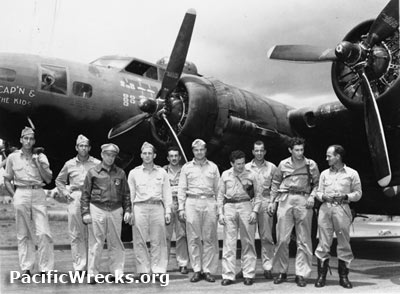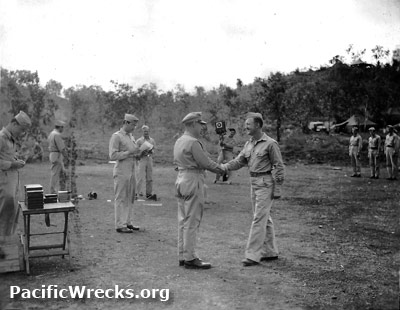General George C. Kenney
U.S. Army Air Force (USAAF), 5th Air Force (5th AF)
Background
George Churchill Kenney was born August 6, 1889 in Yarmouth, Nova Scotia, Canada to parents Joseph Atwood Kenney and Anne Louise Kenney (née Churchill) while on vacation. He was the eldest of four children and grew up in Brookline, Massachusetts. He attended Brookline High School class of 1907 and entered the Massachusetts Institute of Technology (MIT) class of 1907 studying civil engineering.
When his father left the family, Kenney left MIT and took various jobs before becoming a surveyor for the Quebec Saguenay Railroad. When his mother died in 1913, he took a job with engineering company Stone & Webster. In 1914 employed by New York, New Haven and Hartford Railroad as a civil engineer and built a bridge in New London, CT. Afterwards, formed Contracting and Engineering Corporation with a friend and undertook several civil engineering projects.
World War I
On June 2, 1917 enlisted as a flying cadet in the the Aviation Section, U.S. Signal Corps and attended ground school at MIT then primary flight training at Hazelhurst Field in Mineola, NY. On November 5, 1917 commissioned as a Lieutenant and sent overseas for France for additional training. In February 1918 assigned to the 91st Aero Squadron flying the Salmson 2A2. On March 22, 1918 he crashed on take off and was injured. On June 3, 1918 flew his first combat mission. On September 15, 1918 he was intercepted by six German planes and claimed one shot down and another by his observer. For the mission, he earned the Silver Star. On October 9, 1918 he claimed a second aerial victory and earned the Distinguished Service Cross (DSC) bestowed by Brigadier General Billy Mitchell on January 10, 1919.
During January 1941 promoted to the rank of Brigadier General and became the Commanding Officer (C.O.) of the 4th Air Force (4th AF) operating in the west coast of the United States.
Wartime History
On February 26, 1942 promoted to the rank of Major General. During the summer of 1942, three P-38 pilots flew under the Golden Gate Bridge John G. O'Neill, John H. Mangas and Mitchell. The same day, Richard I. Bong buzzed a home of friend who had just got married. As a result of the infraction, the pilots were sent to Kenney who was impressed with the daring young pilots and had them write a letter about safe flying and selected them to accompany him to the South West Pacific Area (SWPA).
During July 1942 sent overseas to Australia. On July 28, 1942 he became the commanding general of Allied Air Forces in the Southwest Pacific and was the highest ranking officer under General Douglas MacArthur in the South West Pacific Area (SWPA).
On September 3, 1942 Kenney becomes Commanding Officer (C.O.) of the 5th Air Force (5th AF) Headquarters in Brisbane and retains command of the Allied Air
Force. As the leader of the 5th Air Force, he fought an innovative and creative war against the Japanese using available aircraft and weapons effectively.
On October 3, 1942 a group of leaders including Field Marshal Sir Thomas A. Blamey, General Douglas MacArthur, General Herring and Kenney plus Minister for the Army Mr. F. M. Forde visit the Australian Army at Owers' Corner at the start of the Kokoda Trail.
Officers under his command created strafer variants of aircraft adding forward firing extra machine guns to the nose of A-20 Havocs and B-25 Mitchells. The 5th Air Force used ordnance including the daisy cutter (wire wrapped bombs) and parachute-retarded fragmentation bomb (parafrag bomb) that were suited for destroying parked aircraft and inflicting damage in jungle areas. Officers under his command pioneered "skip bombing" flying bombers at low level to skip bombs off the surface of the sea to hit an enemy ship instead of ineffective high altitude bombing runs the ship could easily avoid.
On October 15, 1942 promoted to the rank of Lieutenant General and was present at an award ceremony at Mareeba Airfield with Brigadier General Kenneth N. Walker (C. O. 5th Bomber Command) to award the Distinguished Flying Cross (DFC) to members of the 19th Bombardment Group (19th BG). The ceremony was documented by LIFE Magazine photographer George Strock.
During late 1942, assigned B-17E "Sally" 41-633 for use as his personal transport in the South West Pacific Area (SWPA).
On September 5, 1943 Kenney was a passengers aboard B-17F "Cap'n & The Kids / Miss Em" 41-24353 to observe the U.S. Army 503rd Parachute Infantry Regiment (503rd PIR) paratrooper drop over Nadzab. Aboard B-17F "Talisman" 41-24537 was General Douglas MacArthur and B-17F "The Mustang" 42-24554 was General Richard Sutherland. The flight was dubbed by General Kenney as the "Brass Hat's Flight".
On June 15, 1944 the Far East Air Force (FEAF) was reformed with Kenny as the commanding General. On February 1, 1945 promoted to Major General. On March 9, 1945 promoted to the rank of General. He continued into the U.S. Air Force (USAF) until he retired on August 31, 1945.
On July 7, 1944 Kenney summoned Charles A. Lindbergh from Nadzab Airfield back to Brisbane for a reprimand for flying combat missions and received official "observer-status" and permission to use his guns in self-defense. Reportedly, Kenney told him: "...no one back in the States will know whether you use your guns or not."
 |
 |
On March 9, 1945 promoted to the rank of four star General (USAAF).
Postwar
On March 7, 1946 Kenney presented the Medal of Honor earned by Major Thomas B. McGuire, Jr. to his widow Marilynn Elaine “Pudgy” who immediately gave the medal to his father at a 3:00pm ceremony at Paterson City Hall in Paterson, New Jersey.
On March 21, 1946 Kenney was appointed as the first Commander In Chief of the newly formed Strategic Air Command (SAC). On September 18, 1947 he became part of the U.S. Air Force (USAF). Kenney left day-to-day operations at SAC in the hands of his deputy commander, Major General St. Clair Streett and for the first six months of his command was away, focused on being the senior U.S. representative to the United Nations (U.N.) Military Staff Committee.
In January 1947, Streett was replaced by Major General Clements McMullen and continued to handle day-to-day operations. After a poor review of SAC operations, Kenney was removed from command on October 15, 1948. Next,
Kenney became the commander of Air University at Maxwell AFB. In 1949, his first book, General Kenney Reports: A Personal History of the Pacific War (1949) was published, a personal memoir of his service in the South West Pacific Area during World War II. On August 31, 1951 Kenney was promoted to the rank of four star General (USAF).
In September 1951 Kenney retired from the military and resided in Bay Harbor Islands, Florida. That same year, he published his second book, The MacArthur I Know (1951) about General Douglas MacArthur, his commander during World War II.
During 1958-1959 he appeared as the host of the television series Flight (1958-1959). In 1959, his third book, The Saga of Pappy Gunn (1959) was published by Van Rees Press, a biography of Paul "Pappy" Gunn who prewar was in the Philippines helping to establish Philippine Air Lines (PAL) and was commissioned in the U.S. Army Air Force (USAAF) and helped to convert Douglas A-20s of the 3rd Bomb Group into strafers adding four .50 caliber machine guns to the nose and impressed Kenney with his innovation and made him a part of his personal staff.
In 1960, his fourth book, Dick Bong: Ace of Aces (1960) was published by Duell, Sloan and Pearce and reprinted two years later as a paperback Popular Library Edition. This book is written in a narrative style and is a biography of fighter pilot Major Richard I. Bong who flew three tours of duty in Kenney's 5th Air Force between November 1942 until December 1944.
Memorials
Kenney passed away on August 9, 1977 at age 88 in Bay Harbor Islands, Florida. He is buried at Woodlawn Park North Cemetery and Mausoleum in Miami, FL at Mausoleum, Unit 9 Corridor 3 Section 13 Couch Crypt A.
Awards
In April 1949, Kenney became the sixth person to receive the General William E. Mitchell Memorial Award.
References
The Herald "U.S. Air Chief in Australia Promoted" October 16, 1942 page 1
"Australian Associated Press (AP) Washington, Thursday [October 15, 1942]. — Major-General George C. Kenney, who commands the Allied Air Force in the South-West Pacific area, with headquarters in Australia, has been promoted by President Roosevelt to be a Lieutenant-General."
USAF - General George Churchill Kenney
General Kenney Reports: A Personal History of the Pacific War (1949) by General George C. Kenney
The MacArthur I Know (1951) by General George C. Kenney
The Saga of Pappy Gunn (1959) by General George C. Kenney
Dick Bong: Ace of Aces (1960, 1980, 2022) by General George C. Kenney
Air Force Magazine "The Genius of George Kenney" (2002)
FindAGrave - GEN George Churchill Kenney (photo, grave photo)
Contribute
Information
Do you have photos or additional information to add?
|








